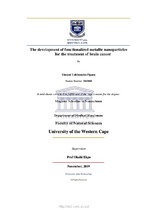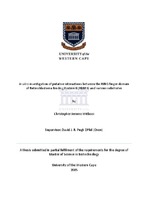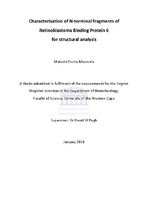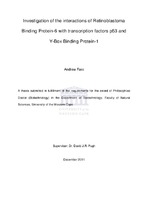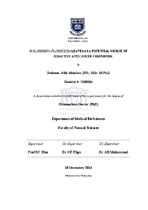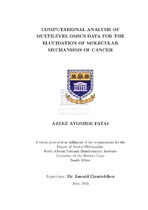Search
Now showing items 1-10 of 27
The development of functionalized metallic nanoparticles for the treatment of brain cancer
(University of the Western Cape, 2019)
Cancers of the nervous system often result from abnormal and uncontrolled growth of cells in nervous tissue. Glioblastoma Multiforme (GBM) and neuroblastoma (NB) are among the most common nervous system-associated cancers ...
In vitro investigation of putative interactions between the RING finger domain of Retinoblastoma Binding Protein 6 (RBBP6) and various substrates
(University of the Western Cape, 2015)
Retinoblastoma Binding Protein 6 (RBBP6) is a RING finger-containing protein which plays a critical role in the 3'-end processing of mRNA transcripts. It is a constituent of the human pre-mRNA processing complex but also ...
In vitro investigation of the ubiquitination and degradation of p53 by Murine Double Minute 2 (MDM2) and Retinoblastoma Binding Protein 6 (RBBP6)
(University of the Western Cape, 2015)
P53 is one of the most important tumour suppressor proteins in the body which protects the cell against the tumourigenic effects of DNA damage by initiating processes such as apoptosis, senescence and cell cycle arrest. ...
Characterisation of N-terminal fragments of Retinoblastoma Binding Protein 6 for structural analysis
(University of the Western Cape, 2016)
Retinoblastoma Binding Protein 6 (RBBP6) is a 200 kDa RING finger-containing protein that plays a role in 3'-end poly-adenylation of mRNA transcripts as well as acting as an E3 ubiquitin ligase against a number of proteins ...
Investigation of the interactions of retinoblastoma binding protein-6 with transcription factors p53 and Y-Box Binding Protein-1
(2011)
Retinoblastoma Binding Protein 6 (RBBP6) is a 250 kDa multi-domain protein that
has been implicated in diverse cellular processes including apoptosis, mRNA processing and cell cycle regulation. Many of these functions are ...
Holarrhena floribunda leaves as a potential source of bioactive anticancer compounds
(University of the Western Cape, 2014)
Cancer is one of the leading causes of morbidity and mortality in developed and developing nations. It is estimated that 86% of new cases and 64% of death due to cancer are from Africa and 13.1 million deaths are estimated ...
The modulating effect of conjugated linoleic acid (CLA) on cancer cell survival in vitro
(University of the Western Cape, 2014)
Conjugated linoleic acids (CLA) are geometrical and positional isomers of n-6 octadecadenoic acid (linoleic acid, LA, 18:2n-6), which form part of a family of essential polyunsaturated fatty acids (PUFA). There are 28 ...
Computational analysis of multilevel omics data for the elucidation of molecular mechanisms of cancer
(University of the Western Cape, 2015)
Cancer is a group of diseases that arises from irreversible genomic and epigenomic alterations that result in unrestrained proliferation of abnormal cells. Detailed understanding of the molecular mechanisms underlying a ...
Evaluating the specancer cell targeting peptides for applications in cancer diagnostics
(University of the Western Cape, 2013)
Cancer is a disease most often associated with poor prognosis. During the development of the
disease, cells acquire genetic mutations which result in changes in bio-molecules (DNA and
protein), thus altering normal ...
The response dynamics of indium telluride quantum dots impedimetric genosensor for telomerase cancer biomarker
(2013)
Cancer, the second most common cause of death after heart disease, is a complex and multifactorial disease that up to date is still under extensive research. To achieve early detection of cancer disease the discovery of ...

